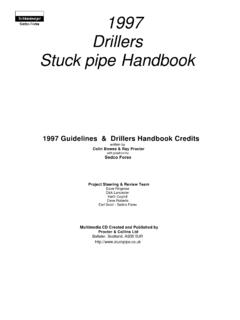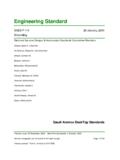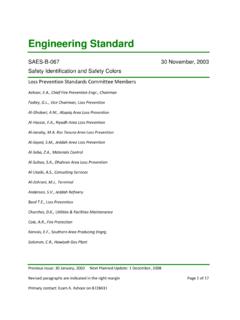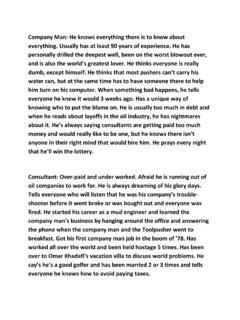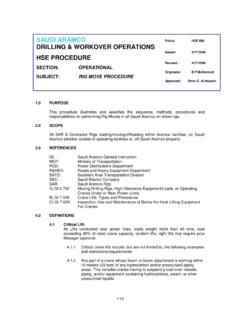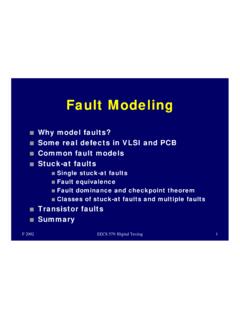Transcription of STUCK-PIPE PREVENTION - Oil Field Trash
1 stuck -PIPEPREVENTIONSELF LEARNING COURSEFEBRUARY, 1997 SchlumbergerAnadrillSELF-LEARNING COURSESTUCK- pipe PREVENTIONSUGAR-LAND LEARNING CENTER ( SLC )2 Page intentionally left blankSELF-LEARNING COURSESTUCK- pipe PREVENTIONSUGAR-LAND LEARNING CENTER ( SLC )3 Introduction to self-learning:Self-learning enables you to learn at your pace, in your time and in your way. This coursebook provides the content, structure and organization of your learning which wouldotherwise be managed by an instructor in a also asks you questions to help you to confirm your understanding (as the instructorprobably would).You will also find a recap section that will be useful for you to review the important pointsstressed in this book after your the end is a glossary containing the key-words relating to the subject, and the answersto the :Each section contains: Explanation of the subject, illustrated as much as possible.
2 Questions (the answers are in Appendix B).How to use the course book: Try to do the course in a maximum of 2 hours, with a break as defined. Set yourself in a suitable environment (no noise, no interruptions, ). After reading a section, use the self-test questions to confirm what you haveunderstood. Write down the answers on a sheet of paper and check the answers at theend of the book. It is your responsibility to answer honestly. If you get an answerwrong, go back to the section indicated and review the subject. A few days later, or at any moment, use the recap section and the glossary to refreshyour knowledge of the :Learning is your responsibility. This book provides you a good preparation before theseminar to the Sugar-Land Learning Center and gives you a chance to learn more by notstruggling with the COURSESTUCK- pipe PREVENTIONSUGAR-LAND LEARNING CENTER ( SLC )4 Page intentionally left blankSELF-LEARNING COURSESTUCK- pipe PREVENTIONSUGAR-LAND LEARNING CENTER ( SLC ) to the STUCK-PIPE PREVENTION self learning is one of the most important problems you will Find in the book will introduce you to STUCK-PIPE , explain the different mechanisms and how toprevent completion of this self-learning course, you will find more information in the IWOB self-learning package, relative to : It is useful to read the Primer of Oilwell drilling before doing this of the course:1.
3 What is a STUCK-PIPE ?2. hole active Dip Recap A : B : Answers to COURSESTUCK- pipe PREVENTIONSUGAR-LAND LEARNING CENTER ( SLC )6T1 and T2, tension : the drill pipe is always in tension when , side force : when 2 surfaces are in contact with a perpendicular side forceacting between them, any attempt to move one surface relative tothe other will result in a friction force resisting the , buoyant weight :apparent weight of the element in the 1 TTSBSELF-LEARNING COURSESTUCK- pipe PREVENTIONSUGAR-LAND LEARNING CENTER ( SLC )71. What is a STUCK-PIPE ?Drilling a well requires a drill string ( pipe & collars) to transmit the torque provided at thesurface to rotate the bit, and to transmit the weight necessary to drill the formation. Thedriller and the directional driller steer the well by adjusting the torque, pulling and rotatingthe drill the drill string is no more free to move up, down, or rotate as the driller wants it to,the drill pipe is stuck .
4 Sticking can occur while drilling, making a connection, logging,testing, or during any kind of operation which involves leaving the equipment in the can define:MO, maximum overpull : the max. force that the derrick, hoisting system, or drill pipe canstand, choosing the smallest , background friction : the amount of friction force created by the side force in the : The force exerted by the sticking mechanism on the BHA(Bottom Hole Assembly)The drill string is stuck if BF + FBHA > MOIn other words, the drill string is stuck when the static force necessary to make it moveexceeds the capabilities of the rig or the tensile strength of the drill pipe . A stuck pipe canresult in breaking a part of the drill string in the hole, thus loosing tools in the few variables must be taken into account when dealing with stuck pipe : pore pressure ofthe formation, mud system, and the depth versus time (the longer in the hole withoutaction, the more likely to get stuck ).
5 The consequences of a stuck pipe are very costly. They include: Lost drilling time when freeing the pipe . Time and cost of fishing: trying to pull out of the hole the broken part of the BHA. Abandon the tool in the hole because it is very difficult or too expensive to remove that case the oil company pays Anadrill to replace the give you an idea, an average cost per well of sticking pipe is about $50 000 US. Ourservice is to avoid the costly loss of the BHA (bottom hole assembly) to the client. Ourresponsibility is to protect the Anadrill tools contained in the 1 : What is a stuck pipe ?SELF-LEARNING COURSESTUCK- pipe PREVENTIONSUGAR-LAND LEARNING CENTER ( SLC )8 Page intentionally left blankSELF-LEARNING COURSESTUCK- pipe PREVENTIONSUGAR-LAND LEARNING CENTER ( SLC )92. MechanismsSELF-LEARNING COURSESTUCK- pipe PREVENTIONSUGAR-LAND LEARNING CENTER ( SLC )10 PhPfMud cakeBorehole wallDrillcollarFigure 2 Differential sticking.
6 Ph is hydrostatic pressure and Pf is ofdrill collarCross sectionin mud cakeHydrostatic forceFormation forceFigure 3 Hydrostatic force and formation force that are acting on the drill COURSESTUCK- pipe PREVENTIONSUGAR-LAND LEARNING CENTER ( SLC ) Differential StickingDifferential sticking is one of the most common causes of pipe sticking. It is due to ahigher pressure in the mud than in the formation fluid. Differential sticking happens whenthe drill collar rests against the borehole wall, sinking into the mudcake. The area of thedrill collar that is embedded into the mudcake has a pressure equal to the formationpressure acting on it. The area of the drill collar that is not embedded has a pressureacting on it that is equal to the hydrostatic pressure in the drilling mud.
7 This is shown inFig. 2. When the hydrostatic pressure (Ph) in the well bore is higher than the formationpressure (Pf) there will be a net force pushing the collar towards the borehole due to differential pressure sticking can be calculated from the product of thedifferential pressure force times the friction factor: Overpull =Ffdp(1)where Fdp = differential pressure force [psi/in2] and f = friction differential pressure force is the difference in hydrostatic force and the formationforce acting on the drill collar. The hydrostatic force is the hydrostatic pressure times thecross sectional area that is in the borehole and the formation force is the formationpressure times the cross sectional area that the mud cake is in contact with. This is shownin Fig. 3. Note that the cross-section area is used to calculate the force but not the surfacearea of the drill collar.
8 The differential pressure force is defined: ()FAPP dpmchf= 144 in22/ft()(2)where Fdp = differential pressure force [lbf], Amc = cross section embedded in mud cake[ft2], Ph = hydrostatic pressure [psi], and Pf = formation pressure [psi].The friction factor depends on the formation and the drill collar surface. It varies to hydrostatic pressure is defined: PTVDTVDh= = 0433. ppg(3)where Ph = hydrostatic pressure [psi], TVD = true vertical depth [ft], = pressure gradientof the mud [psi/ft], and = mud weight [ppg]. Fresh water has a density of ppg anda pressure gradient of psi/ft. Formation brine in the Gulf of Mexico is 9 ppg, whichis equal to COURSESTUCK- pipe PREVENTIONSUGAR-LAND LEARNING CENTER ( SLC )12 BridgingMud cakeBorehole wallDrillcollarFigure 4 Bridging occurs when the drill collar is left cakeDrill pipeDrill pipe erosionWiper trip erosionReaming erosionFigure 5 Three types of filter cake erosion: Drill pipe erosion, wiper trip erosion, andreaming COURSESTUCK- pipe PREVENTIONSUGAR-LAND LEARNING CENTER ( SLC )13 The formation pressure is usually not known.
9 There is no direct way of calculating it likethe hydrostatic pressure. Usually there is an estimation of the pressure gradient for theformation that is being drilled. That value can then be used to estimate the thickness of the filter cake is critical in differential sticking. The thicker the filter cakethe bigger is the cross sectional area that the formation pressure acts on (see Fig. 3).Thus, the differential sticking force is higher when the mud cake is thicker. When the wellbore pressure is higher than the formation pressure some of the mud filtrate ( mud filtrate is the liquid phase of the drilling mud) will invade the formation if it is permeable andporous. Thus, a mud cake will build up on the surface of the well bore. The thickness ofthe mud cake depends on the mud properties and the porosity of the formation.
10 At acertain point the mud cake will become thick enough to act as a barrier to stop furtherseeping of the mud filtrate into the formation and the mud cake will then stop growing. Ifthe mud has a lot of drill solids then the filter cake will be more porous and permeableresulting in a thicker mud cake and faster growth. The ideal situation would be a thin,hard mud cake made up of mud solids danger of differential sticking is usually in a sand. Sand formations have usually highporosity and permeability and therefore a thick mud cake tends to build pipeIf the drill pipe is not moved for a period of time the filter cake tends to build up around itand then add to the differential sticking force that is holding the drill collars. This isshown in Fig. 4. The mud cake forms a bridge between the drill collar and the mud cakein the Cake ErosionFilter cake erosion happens when the drill pipe rubs against the borehole wall.
